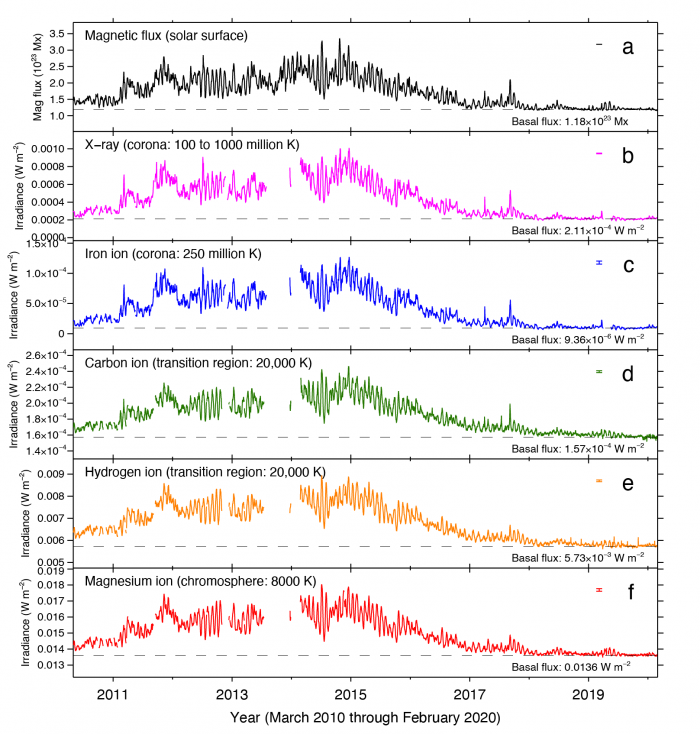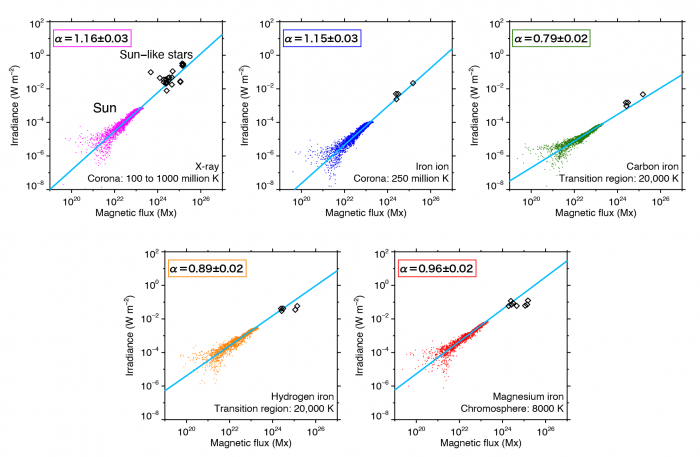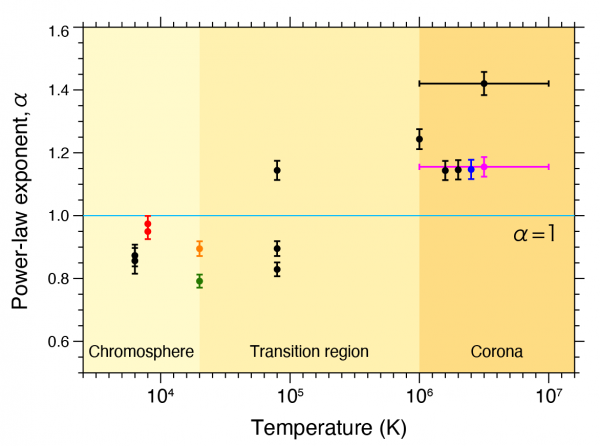Overview
The Sun and solar-type stars (stars similar to the Sun but with a variety of ages and activity levels) have coronae with temperatures exceeding 1 million degrees Celsius, and chromospheres whose temperatures extend up to 10,000 degrees. The surface of the Sun and solar-type stars is at a cooler 6,000 degrees, but the ultra-hot gases of the corona and chromosphere are hot enough to emit X-rays and ultraviolet rays. These high-energy X-ray and UV photons can impact the climate and habitability of any surrounding planets by stripping their atmospheres and instigating photochemical reactions. However, it has remained an unresolved mystery as to how this ultra-high temperature gas in the stars is heated, particularly whether a heating and radiation mechanism is common to all solar-type stars. This study compared and analyzed 10 years of multi-wavelength observation data from the Sun, and that of previous observations of solar-type stars, and investigated correlations in their surface magnetic fields, and the emission lines at different wavelengths in the corona and chromosphere (X-rays, ultraviolet, visible light and radio waves). The results found that the correlation between the magnetic field of the Sun and the emission lines is exactly replicated in solar-type stars at all wavelength bands. This is key evidence that the ultra-high temperature gas in the Sun and in solar-type stars is heated by a common mechanism, independent of the star's age or activity, and that specifically, the energy is transmitted through the magnetic field extending outwards from the stellar surface into space. By combining the results of this work with detailed observations using the next-generation solar observation satellites and space telescopes, it will be possible to reproduce the X-ray and ultraviolet spectra from a variety of stars, which will allow the habitability of exoplanets to be examined more precisely.
Research Summary
- Dr TORIUMI Shin, an International Top Young Fellow (ITYF) at the Institute of Astronautical Science at JAXA, and Professor Vladimir AIRAPETIAN at NASA GSFC/American University combined and analyzed solar and stellar observational data to reveal that the ultra-hot gas universally present in these stars is heated by a common mechanism, independent of the age or activity level of the star.
- Multi-wavelength long-term observations of the Sun have revealed a correlation between the magnetic field on the Sun's surface and the emission lines at different wavelengths (X-ray, ultraviolet, visible light and radio waves) emitted from the corona and chromosphere. Comparison with observational data of solar-type stars showed that this correlation is shared between the Sun and other solar-type stars.
- The heating mechanism of the corona and chromosphere shown in this study is expected to be understood more precisely in the up-coming detailed Sun and stellar observations by the next-generation satellites such as Solar-C (EUVST) and WSO-UV. Additionally, the extension of this research will provide X-ray and ultraviolent stellar spectra that can be used for input in planetary atmospheric formation and dissipation models, allowing us to examine the climate and habitability of exoplanets with greater precision.
The stellar surface of the Sun and solar-type stars (※1) have temperatures of about 6000 degrees Celsius. However, the stellar atmosphere of these stars includes the corona with a temperature of over 1 million degrees Celsius, and the chromosphere which can reach temperatures of 10,000 degrees Celsius. These ultra-high temperature layers emit X-rays and ultraviolet radiation that play an important role in the formation and photochemical reactions in the atmosphere of Solar System and extrasolar planets. In particular, the Sun in the past (and young solar-type stars) is thought to have generated X-rays and ultraviolent rays that are 10 to 1000 times stronger than emitted today. This suggests that active stars when young, including the Sun, had a strong influence on the evolution of the climate and habitability of their orbiting planets.
Despite this importance, the mechanism of the corona and chromosphere remains poorly understood (※2). In the Sun, the main theory is that convective motion on the solar surface shakes the magnetic field lines, and this energy is transmitted upwards to heat the corona and chromosphere. However, it is not clear whether this mechanism can universally explain the formation of the ultra-high temperature gas and the radiation emitted at different wavelengths in all active solar-type stars.
The solar magnetic field plays a key role in the heating mechanism in the Sun. If the relationship between the magnetic field and ultra-high temperature gas in other solar-type stars can be established to be consistent with that found for the Sun, then the same mechanism should be responsible for heating the ultra-high temperature gas as in the Sun. In this study, we therefore investigated the correlation between emission lines at different wavelengths (X-rays, ultraviolet rays, visible light, and radio waves) and the surface magnetic field of the star over the wide temperature range found in the corona and chromosphere. The different wavelengths of the solar and stellar emission lines are produced at different temperatures within the star (for example, X-rays and shorter-wavelength ultraviolet rays are mainly emitted from the corona, whereas longer-wavelength ultraviolet rays and visible light emission is mainly from the chromosphere). This makes it possible to understand the gas at a variety of different temperatures by analyzing the corresponding emission lines at different wavelengths.
We first used multi-wavelength observation data taken over a 10 year period from May 2010 to February 2020 to investigate the level of magnetic flux on the surface of the Sun, and the fluctuations in the brightness of the various emission lines that correspond to the corona and chromosphere. Figure 1 shows the level of magnetic flux and the fluctuations in five typical emission lines. The fine peaks in each curve indicate the presence of sunspots crossing the solar surface as the Sun rotates, which increases the magnetic flux on the surface and correspondingly heats the corona and chromosphere above the surface and so strengthens the emission lines.
Figure 1: The total magnetic flux from the Sun and intensity of five emission lines. (a) Total magnetic flux on the surface of the Sun measured by the SDO satellite (daily variation), (b) - (f) X-rays (5.2 - 124Å), iron ions (284Å), carbon ions (1335Å), hydrogen ions (2796Å), and magnesium ions (2796Å) measured by SORCE satellite. Irradiance data is converted to a value at 1 astronomical unit from the Sun (average distance of the Earth form the Sun), and missing values are mainly due to the suspension of observations with the SOURCE satellite (from Toriumi & Airapetian, 2022).
In Figure 2, the level of magnetic flux is plotted against the intensity of the emission lines obtained in Figure 1. Magnetic flux is on the horizontal axis, and the intensity of each emission line is plotted on the vertical axis (data is depicted in the coloured dots). The dots show that the emission lines at temperatures from within the corona and chromosphere become brighter with increasing magnetic flux. The straight line in the figure shows a power-law correlation between the magnetic flux level and the emission line brightness. The slope of the straight line (described by the exponent, α) indicates the efficiency with which gas in the solar atmosphere that is heated by the surface magnetic flux on the Sun.
Figure 2: Comparison of solar and stellar observation data. The coloured dots show the increase of the irradiance with the surface magnetic flux that was obtained in Figure 1. The light blue line shows the correlation (power law) obtains by fitting a straight line to the solar data. The value of the slope α for the correlation is noted in the upper-left corner of each panel. In addition, ◇ represents the magnetic flux and irradiance data for solar-type stars with ages ranging from about 50 million to 4.5 billion years (from Toriumi & Airapetian, 2022).
Figure 2 also shows the observation data for solar-type stars of different ages and activities, ranging from ages of about 50 million years to 4.5 billion years (data shown by ◇). This clearly reveals that solar-type stars extend along the same correlation as that for the Sun for any emission line that originates from the corona to chromosphere. The correlation and slope are important indicators of the heating mechanism of the gas from the magnetic field on the surface of the star, and this figure shows that the heating efficiency of the gas is the same for both the Sun and other solar-type stars. The ultra-high temperature gas of these stars must therefore be heated by a common mechanism, independent of the age and activity of the star.
Figure 3: The slope α of the power law correlation between the surface magnetic flux and the irradiance at different temperatures is plotted here for the Sun. This plot shows not only the five typical emission lines (coloured data) that were shown in Fig. 1 and Fig. 2, but all the emission lines analysed in this study (X-rays, ultraviolet rays, visible light, and radio waves). The boundary temperature between the corona, transition layer and chromosphere are shown as a guide (from Toriumi & Airapetian, 2022).
Figure 3 plots the slope of the correlation (power law) at different temperatures for all the emission lines analysed in this study, including the five emission lines that were shown in Figs. 1 and 2. This figure shows that the slope tends to weaken as you move from the corona above 1 million degrees Celsius to the chromosphere at around 10,000 degrees Celsius. This indicates that while the corona experiences high heating efficiency with respect to the magnetic field on the stellar surface, this efficiency decreases in the chromosphere and suggests a different heating mechanism to that in the corona must be in operation. What is particularly interesting is that although the slope value (i.e. the heating mechanism and efficiency) differs greatly between the corona and chromosphere, within each region, the Sun and solar-type stars show a common slope (mechanism / efficiency).
"It has been previously theorized that the Sun's surface magnetic field is a driver for the high temperatures in the corona and chromosphere," remarked Toriumi Shin, lead author of this paper and ISAS International Top Young Fellow. "However, it was not until we saw that the correlations between the hot gas emissions at multiple wavelengths and temperatures did we realize this might be a way of predicting the production of the most energetic radiation from a star which impacts the evolution of any hosted planetary system."
This study revealed for the first time that the mechanism by which ultra-high temperature gas is heated is closely related to the magnetic field, and is universal for the Sun and other stars. Since these ultra-high temperature gases emit X-ray and ultraviolet radiation that can have a strong effect on the surrounding planets, the clarification of part of the heating mechanism from this work is a key achievement to understanding planets and exoplanets.
"This study suggests that the mechanisms of atmospheric heating in the Sun and young solar-like stars have common nature," said Vladimir Airapetian, senior astrophysicist, NASA Goddard Space Flight Center and professor at American University, Washington, D.C. "It opens a new and exciting opportunity to characterize the fluxes of ionizing radiation in the form of X-ray and extreme UV bands at the time when life started on Earth and other exoplanets to understand their impact on habitable worlds. Our results will also help to develop observational strategies to search for signatures of life or biosignatures with the James Webb Space Telescope and other missions." Airapetian's contributions to the study were funded by a grant from Hubble Space Telescope and European Space Agency's XMM-Newton mission that aims to understand the lives of young suns.
Further insights leading from this research are expected from up-coming solar observation satellites and space telescopes. Firstly, the EUV high-throughput Spectroscopic Telescope, "Solar-C (EUVST)" (※3), which is scheduled to be launched in the latter half of the 2020s, is an ultraviolet space telescope with unprecedented high resolution and sensitivity that will perform spectroscopic diagnostics of the chromosphere, transition region, and corona without any gaps in temperature. This is anticipated to clarify the details of the heating mechanism common to the Sun and solar-type stars revealed in this study. Additionally, the World Space Observatory - Ultraviolet, "WSO-UV", for which Japan is developing an observational equipment, will carry out observations of planetary atmospheres of transiting extrasolar planets (where the planet passes in front of the star when viewed from the Earth). Monitoring the host star in the ultraviolet for a long period of time should provide clues to clarify how the stellar gas and activity change with the appearance of star spots on the stellar surface.
In uncovering the correlation between the brightness and level of magnetic flux for different emission lines, it has also become possible to determine the intensity of the emission line based on the level of magnetic flux for any solar-type star. Applications of this will make it possible to provide X-ray and ultraviolet spectra that can be used as the input to models exploring the formation and dissipation of planetary atmospheres for worlds that orbit solar-type stars. This research therefore has developments that can lead to information not only on the Sun and stars, but also that of planetary climate and habitability.
Speaking about this discovery, Professor IKOMA Masahiro from the National Astronomical Observatory of Japan, said: "The diverse exoplanetary systems discovered so far tell us that the formation of planets and planetary systems is greatly affected by various violent processes that we could not imagine when we knew only of the Solar System. One of those is the massive mass loss of planets--a planet itself may even disappear or evaporate once it is born. This strongly suggests that the existence of atmospheres and oceans, which are essential for the existence of life, cannot be taken for granted. The loss process is governed by the irradiation of high-energy photons from the central star and, thereby, photochemistry in the planetary atmosphere. Understanding the stellar emission is therefore essential to unveiling the formation of planets and identifying planets that might support environments for life. In the next decade, the two missions, WSO-UV and Ariel, which JAXA participates in, will reveal photochemical, radiative, and hydrodynamic processes in exoplanet atmospheres. Putting those pieces of knowledge together will help us better understand the origin and diversity of planets and planetary systems and identify habitable planets."
Glossary of terms
1. Solar-type / Sun-type star: A main sequence star with a spectral type known as a "G-type". The temperature of surfaces of these stars is about 5000 - 6000 degrees Celsius. From observations of young solar-type stars, it is thought that the young Sun produced X-rays and ultraviolet rays that were 10 to 1000 times stronger than at present. In this study, we analysed solar-type stars that are about 50 million to 4.5 billion years old.
2. Solar atmospheric heating problem: Above the solar surface (photosphere: approximately 6000 degrees Celsius) there exists layers of ultra-hot gases (atmosphere) referred to as the chromosphere (approx.. 10,000 degrees Celsius), the transition region (10,000 ~ 1 million degrees Celsius), and the corona (over 1 million degrees Celsius). However, the reason why temperatures increase as the distance from the Sun, which is supposed to be the source of the heat, increases, and how the chromosphere and corona are created, is not understood. So far, "wave heating theory" in which convective motion on the solar surface shakes the magnetic field lines and generates waves that propagate upward and release energy, and "nanoflare theory", in which the atmosphere is heated by minute explosions between the magnetic field lines that are then shaken, have been proposed.
3. Solar-C (EUVST): The next solar observation satellite planned by JAXA as a successor to the Hinode satellite. Equipped with an ultraviolet telescope with high spatiotemporal resolution and sensitivity, Solar-C will be able to spectroscopically observe the chromosphere, transition region, and corona of the Sun in detail, without gaps in temperature, and take on the mystery of atmospheric heating and flare explosions.
Publication Information
Paper title:Universal Scaling Laws for Solar and Stellar Atmospheric Heating
Journal title:The Astrophysical Journal
Publication date:15 March 2022
DOI:10.3847/1538-4357/ac5179
Corresponding author・affiliation:Toriumi Shin・Japan Aerospace Exploration Agency
Co-author・affilation:Vladimir S. Airapetian・NASA Goddard・American University



